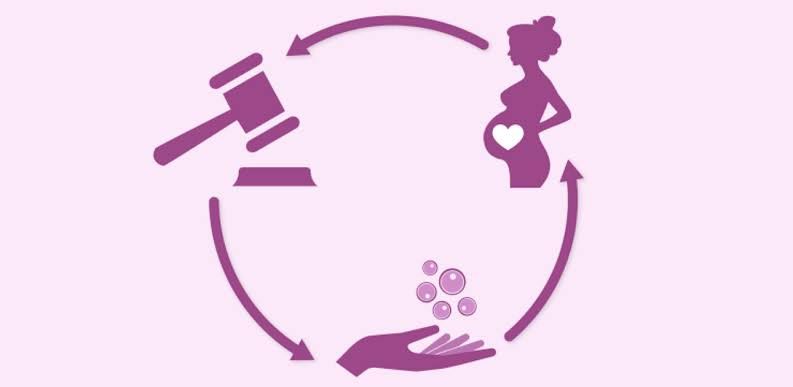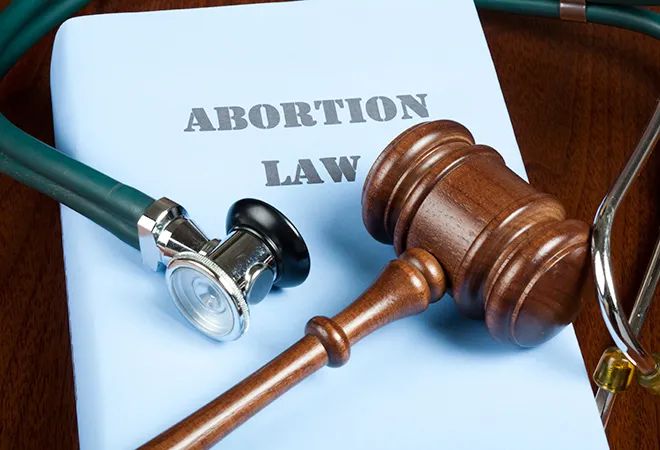ABORTION LAWS AND THE REPRODUCTIVE RIGHTS OF A WOMEN IN INDIA
A CRITICAL REVIEW

Shwetha Sureshkumar
Amity University Dubai
B.B.A. LLB (Hons.) (2025)
ABSTRACT
The legal status of abortion varies greatly from nation to nation and even within nations, depending on the jurisdiction. Generally, abortion laws govern both the conditions and procedures that may be utilized to lawfully end a pregnancy. While some nations legalize abortions without restrictions in the first several months of pregnancy, others only do so when the mother’s life or health is in danger. Nonetheless, there have been other attempts since then to limit access to abortion, notably through state-level laws like waiting periods, required counselling, and financing restrictions. Abortion regulations are a complex and frequently divisive subject, with differing ethical, religious, and political viewpoints.
In India, despite the fact that abortion is permitted, it is important to note that many women, especially those from underrepresented groups, still face difficulty accessing safe and legal abortions. As a result of the social stigmas associated with abortion, it may be challenging for women to get the care they require.
Keywords: Abortion regulations, social stigmas, Legalize Abortions, MTP Act 1971, India
INTRODUCTION
Women’s reproductive rights and abortion legislation are delicate and extremely contentious issues that have been the focus of continuing discussions and arguments for decades. This issue is fundamentally about a woman’s freedom to decide whether or not to end a pregnancy, as well as the societal and legal restrictions that frequently place restrictions on this decision.
They should have the freedom to make choices about their own bodies, according to proponents of reproductive rights, and having access to secure and legal abortions is a crucial component of this autonomy. Additionally, they contend that prohibiting or restricting access to abortion can have negative effects on women’s health, general well-being, and social and economic circumstances. The foetus has a right to life, according to abortion opponents, who claim that it is ethically reprehensible to abort a foetus. They contend that abortion ought to be prohibited unless the mother’s life is at risk.
Political, ethical, and legal issues are all present in the complicated and diverse discussion about abortion regulations and reproductive rights. While some nations have loosened regulations, others have strengthened them regarding abortion. The problem is made more complicated by elements like religion, culture, and personal convictions.
RIGHTS OF ABORTION
The basis of freedom is the acceptance of the inherent worth and unalienable rights of every member of the human family. Human rights are those liberties that ought to be available to everyone, free from all forms of prejudice. The right to life is a person’s most valuable right. It is the most important human right, and no exceptions are allowed. It cannot be lost. In September 2021, the Medical Termination of Pregnancy (Amendment) Act of 2021 increased the maximum gestational limit for abortion from 20 to 24 weeks,
The amendment was hailed as the next step toward more progressive Indian abortion legislation, despite the fact that it did not recognize abortion on demand as a pregnant person’s right. The amendment was a response to numerous women who had undesired pregnancies that went beyond the acceptable gestation period requesting access to safe medical support through the Indian courts.
A purposive interpretation was chosen by the Supreme Court in the matter of X v. The Principal Secretary, Health and Family Welfare Department, Govt. of NCT of Delhi & Anr., as opposed to a restrictive one. The court’s ruling is regarded as revolutionary because of its progressive outlook.
The goal of this decision is to greatly emphasise the value of women’s physical and reproductive autonomy, as well as the right to privacy and dignity guaranteed by Article 21 of the Constitution. According to the article, married and single women are equally entitled to the right to choose how many children to have, making it a right that extends beyond mere survival and includes the right to live with dignity
It also signified the aspects of Article 14, the state cannot deny anyone equality before the law or equal protection under the law. It would be against the spirit of Article 14 to forbid single or unmarried pregnant women (whose pregnancies are between twenty and twenty-four weeks) from having an abortion while permitting married women to do so at the same time.
The morality of induced abortion as well as the ethical bounds of the executive branch of government can both be considered when describing a person’s attitude on abortion.
The right of a woman to have an abortion is supported by her individual rights, including her right to life, liberty, and the pursuit of happiness. Internationally, it is acknowledged that improving the basic rights of women and fostering development are mutually exclusive goals. Governments from all across the world have recently recognised and committed to advancing abortion rights to a previously unheard-of degree. Structured laws and policies are important determinants of how committed a government is to advancing reproductive rights. Bodily rights, also referred to as the right of every woman to govern her body, are inalienable.
REPRODUCTIVE RIGHTS IN INDIA
The Indian Constitution acknowledges the fundamental human right to life and equality. Although India has made great strides in the area of reproductive rights, there are still major obstacles that must be overcome.
Reproductive rights in India include the freedom to decide whether to have children, the ability to obtain safe and legal abortion services, and the right to information and services relating to reproductive health. To enhance reproductive health services and guarantee access to contraception and family planning services, the government has implemented a number of policies and programs.
Nonetheless, despite these initiatives, securing reproductive rights in India still faces several difficulties. Some of these issues include inadequate sex education, gender-based discrimination, and limited access to reproductive health services, all of which can prevent people from accessing data and resources related to reproductive health. The availability and grade of maternal health care services are also still seriously lacking, which can result in high rates of maternal mortality and morbidity. This is especially true for marginalised groups like rural and tribal populations, where healthcare access is frequently constrained.
The question of abortion rights in India is also a topic of ongoing discussion and legal contention. Despite the fact that abortion is permitted in India, there are still many obstacles standing in the way of women being able to obtain safe and legal abortions, such as social stigma and a shortage of qualified medical personnel.
While India has made strides in advancing reproductive rights, much more needs to be done to guarantee that everyone has access to dependable reproductive health services and that their rights to an uninhibited sexual and reproductive life are upheld.
The crime of inducing a woman to miscarry is covered by Section 312 of the IPC . According to the law, whomever intentionally causes a pregnant woman to miscarry shall be punished with either physical or mental imprisonment for a term that may not exceed three years, or with a fine, or with both. It is vital to emphasize that this clause only applies to purposeful acts that cause a woman to miscarry; it does not apply to cases of unintentional injury or natural miscarriage. The goal of this section is to safeguard pregnant women’s and their unborn children’s lives and health.
When a woman miscarries as a result of deliberate damage from another person, that person may be held accountable under the section. The facts of the case and the extent of the harm done to the female and her unborn child will determine the harshness of the sentence. So it’s crucial to watch out that the legislation isn’t applied improperly to punish miscarriage victims. It is not fair to punish women for naturally occurring biological processes that are outside of their control, as miscarriages can occur for a variety of causes, most of which are beyond a woman’s control.
The MTP Act further expands the right to an abortion. The Medical Termination of Pregnancy Act’s objectives and justifications are as follows: The Indian Criminal Code’s pregnancy termination laws, which were passed roughly a century ago, were drafted in accordance with the relevant sections of British law at the time. Abortion was declared a crime for which both the woman and the abortionist might face punishment, with the exception of cases when the abortion had to be induced to preserve the mother’s life. It has been reported that a significant number of cases nationwide involve the violation of this highly strict law.
In India, abortion was legalised by the Medical Termination of Pregnancy Act, 1972. Nonetheless, the majority of women still lack access to safe abortion procedures today. Women continue to turn to risky behaviours and self-induced abortions since legal abortion services are difficult to get, which makes a farce of the legalisation of abortion. According to studies, there are 2.2 illegal abortions for every one that is legal. Also, it is obvious that legalising abortion has been and still is a method of coercive population control.
According to the Supreme Court, Article 21 of the Constitution implicitly protects the right to privacy, and this right can be interpreted to include the right to an abortion.
In the case of Murari Mohan Koley vs. The State a woman wanted to have abortion on the ground that she has a 6 month old daughter. She approached the petitioner for an abortion. And the petitioner agreed to it for a consideration. But somehow the condition of the woman worsened in the hospital, and she was shifted to another hospital. But it resulted in her death. The abortion was not done. The petitioner who was a registered medical practitioner had to establish that his action was done in good faith so that he can get exemption from any criminal liability under section 3 of the MTP Act, 1971.
TAKING A STEP BACK AFTER MAKING PROGRESS
Anti-reproductive rights views seem to have eclipsed the good progress of 2021 and 2022 in 2023. A year after the ruling in X v. Principal Secretary, this pro-rights movement suffered a significant setback that highlighted the amount of work that had to be done before India can become a fully liberal and right-based jurisdiction for medical abortion.
In the case of X v. Union of India that came out in October, 2023, a married 27-year-old mother of two petitioned the Supreme Court to obtain an abortion in accordance with the Medical Termination of Pregnancy Act, 1971. Due to a medical ailment called lactational amenorrhea, which causes breastfeeding women to stop menstruation, the petitioner found out she was pregnant at about 24 weeks. The petitioner swiftly went to the supreme court to get access to necessary treatment after initially being denied at the medical facility. The arguments for foetal viability and worries about the rights of the unborn child were heard and given precedence over the petitioner’s right to reproductive autonomy in a very dramatic turn of events at the Supreme Court.
Despite fulfilling the legal requirements of mental health concerns, her reproductive rights were measured against a checklist for eligibility for termination beyond 24 weeks, and were found wanting. The Court noted that she did not attract Section 3(2B) protections which covered sexual assault survivors, minors, widowed or divorced persons, disabled persons, mentally ill persons, foetal abnormality or pregnancy during humanitarian crises. She also did not attract Section 5 protections which allow termination of pregnancy in cases where it is necessary to save the life of the woman.
Firstly, the Court’s understanding of mental illness as a ground for termination was unclear. Despite the Petitioner’s multiple submissions regarding her mental health, postpartum depression and psychosis, suicidal tendencies and tendency to cause harm to herself and her children, the Court refused to permit termination based on these grounds. Secondly, with the petitioner’s concerns of suicide considered and rejected, the judgement begs the question as to what constitutes a threat to a woman’s life?. It was suggested to give a full exercise of reproductive autonomy as they referred to the case of Suchitra Srivastava v Chandigarh Administration, the woman has to prove the dangers of her circumstance and her absolute need for an abortion
In the final verdict, it was held that an abortion could not be granted, keeping in mind that the upper gestational statutory limit of 24 weeks had been crossed. Since the Medical Board’s reports did not indicate any immediate necessity to save the Petitioner’s life by way of a termination, S. 5 could not be invoked.
Furthermore, the Court, using its ‘complete justice’ powers was “averse” to issuing a direction to stop the foetus’ heartbeat, and it was observed that the Petitioner was also opposed to such a direction. Progressive judgments have been tainted in India by a “moral” argument that has infiltrated the narrative through an unofficial route. The idea that everyone should be concerned about a woman’s choices has cleverly sidestepped the right-based discourse. This is the strain of a cultural bias that, in the face of public morality, is permitted to rear its censorious head even in the legal system, eroding the advancements made there.
CONCLUSION
The Rights of Abortion should be left up to the mother’s discretion. Nonetheless, the unborn should be given the essential protection, taking the viability of a legal norm into consideration. In cases where the government or non-profit groups are prepared to care for the unborn, it is also advantageous to the mother. Giving the woman the power to kill the foetus serves no purpose. Her only option is to terminate her pregnancy. Additionally, it is claimed that having 20 million new borns per year would place a bigger burden on the nation’s healthcare system and financial resources than, say, having one to five million abortions every year. In between one and five million abortions annually.
The mother’s and the unborn child’s freedoms must be protected by the law. We should look for ways to support abandoned and lonely mothers as well as lonely and scared babies as a hospitable society. We must provide unexpected pregnant women with the love and care they need, as well as help them locate humane abortion options.
While some nations have loosened limitations on abortion, others have increased them, which has made it more difficult and complicated for women to use their right to contraception. It is crucial to take into account the experiences and viewpoints of those who are most directly touched by these laws and prohibitions, such as women and marginalized populations, as we continue to negotiate this thorny issue. Furthermore, it is critical to acknowledge that access to safe and legal abortions is a vital component of reproductive healthcare, as is the requirement for comprehensive healthcare services.




